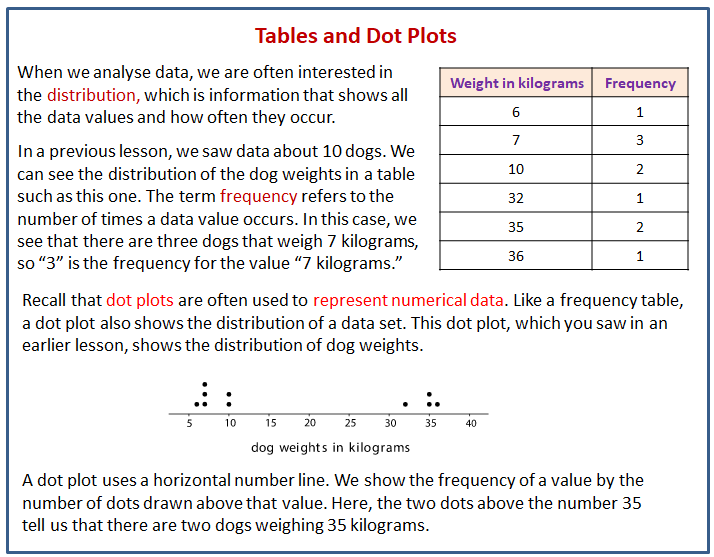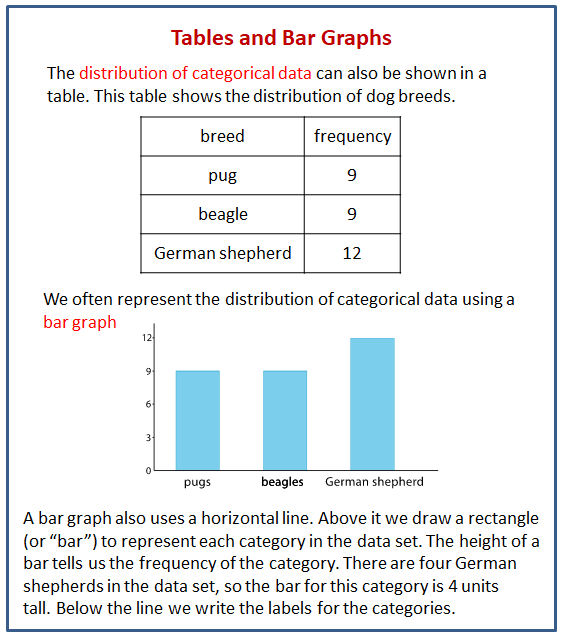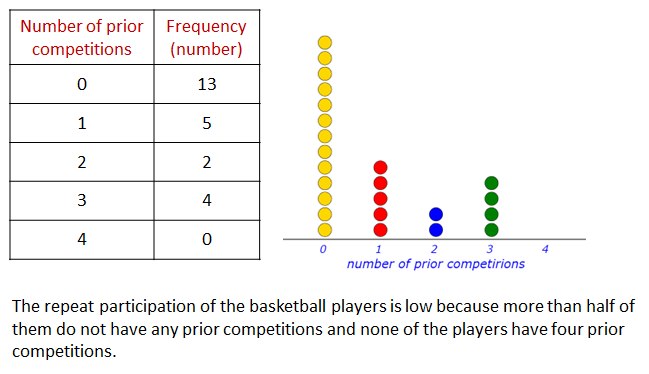Illustrative Mathematics Unit 6.8, Lesson 3: Representing Data Graphically
Learning Targets:
- I can describe the information presented in tables, dot plots, and bar graphs.
- I can use tables, dot plots, and bar graphs to represent distributions of data.
Related Pages
Illustrative Math
Grade 6
Lesson 3: Representing Data Graphically
Let’s represent data with dot plots and bar graphs.
Illustrative Math Unit 6.8, Lesson 3 (printable worksheets)
Lesson 3 Summary
The following diagram shows how the frequency of numerical data can be represented in a table and in a dot plot.

The following diagram shows how the frequency of categorical data can be represented in a table and in a bar graph.

Lesson 3.1 Curious about Caps
Clare collects bottle caps and keeps them in plastic containers.
Write one statistical question that someone could ask Clare about her collection. Be prepared to explain your reasoning.
Scroll down the page for the solutions to the “Are you ready for more?” section.
Lesson 3.2 Estimating Caps
- Write down the statistical question your class is trying to answer.
- Look at the dot plot that shows the data from your class. Write down one thing you notice and one thing you wonder about the dot plot.
- Use the dot plot to answer the statistical question. Be prepared to explain your reasoning.
Lesson 3.3 Been There, Done That!
Priya wants to know if basketball players on a men’s team and a women’s team have had prior experience in international competitions. She gathered data on the number of times the players were on a team before 2016.
- Did Priya collect categorical or numerical data?
- Organize the information on the two basketball teams into these tables.
- Make a dot plot for each table.
- Study your dot plots. What do they tell you about the competition participation of: a. the players on the men’s basketball team? b. the players on the women’s basketball team?
- Explain why a dot plot is an appropriate representation for Priya’s data.
Are you ready for more?
Combine the data for the players on the men’s and women’s teams and represent it as a single dot plot. What can you say about the repeat participation of the basketball players?
Lesson 3.4 Favorite Summer Sports
Kiran wants to know which three summer sports are most popular in his class. He surveyed his classmates on their favorite summer sport and collected these responses:
- Did Kiran collect categorical or numerical data?
- Organize the responses in a table to help him find which summer sports are most popular in his class.
- Represent the information in the table as a bar graph.
- a. How can you use the bar graph to find how many classmates Kiran surveyed? b. Study your bar graph, and answer Kiran’s question about the top three summer sports in his class. Then, make at least one other observation, based on your bar graph, about his classmates’ preferred summer sports.
- Could a dot plot be used to represent Kiran’s data? Explain your reasoning.
Glossary Terms
distribution
The distribution tells how many times each value occurs in a data set. For example, in the data set blue, blue, green, blue, orange, the distribution is 3 blues, 1 green, and 1 orange.
frequency
The frequency of a data value is how many times it occurs in the data set.
Lesson 3 Practice Problems
- A teacher drew a line segment that was 20 inches long on the blackboard. She asked each of her students to estimate the length of the segment and used their estimates to draw this dot plot.
a. How many students were in the class?
b. Were students generally accurate in their estimates of the length of the line? Explain your reasoning. - Here are descriptions of data sets. Select all descriptions of data sets that could be graphed as dot plots.
A. Class size for the classes at an elementary school
B. Colors of cars in a parking lot
C. Favorite sport of each student in a sixth-grade class
D. Birth weights for the babies born during October at a hospital
E. Number of goals scored in each of 20 games played by a school soccer team - Priya recorded the number of attempts it took each of 12 of her classmates to successfully throw a ball into a basket. Make a dot plot of Priya’s data.
- Solve each equation.
a. 9v = 1
b. 1.37w = 0
c. 1 = 7/10 x
d. 12.1 = 12.1 + y
e. 3/5 + z = 1 - Find the quotients.
a. 2/5 ÷ 2
b. 2/5 ÷ 5
c. 2 ÷ 2/5
d. 5 ÷ 2/5 - Find the area of each triangle.
The Open Up Resources math curriculum is free to download from the Open Up Resources website and is also available from Illustrative Mathematics.
Try out our new and fun Fraction Concoction Game.
Add and subtract fractions to make exciting fraction concoctions following a recipe. There are four levels of difficulty: Easy, medium, hard and insane. Practice the basics of fraction addition and subtraction or challenge yourself with the insane level.

We welcome your feedback, comments and questions about this site or page. Please submit your feedback or enquiries via our Feedback page.
